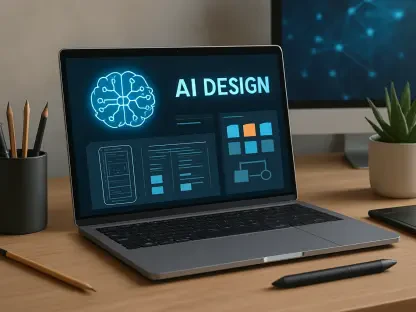The landscape of cybersecurity is undergoing a radical transformation due to the integration of artificial intelligence (AI). Traditional methods of cyber defense are proving inadequate against the sophisticated, AI-powered threats that are emerging. As cybercriminals leverage AI to automate and enhance their attacks, the need for equally advanced defensive strategies has become paramount. This article delves into the ways AI is reshaping cyber threats and explores the implications for future security strategies.
The Evolution of Cyber Threats
Cyber threats have evolved significantly from their early days. Initially, attacks were manual and relied on predictable methods such as phishing and SQL injections. At that time, traditional defenses like firewalls and antivirus software were generally effective in countering these attacks. However, the advent of AI has brought about a new era of cyber threats that are more dynamic and efficient, rendering many traditional defenses obsolete.
AI enables attackers to automate processes, making their attacks more sophisticated and difficult to detect. For example, AI can be used to quickly scan networks for vulnerabilities and rapidly deploy malware. This shift from manual to automated attacks has fundamentally changed the threat landscape, increasing the speed and scale at which cybercriminals can operate. With AI, attackers can also continuously adjust their tactics in real-time, ensuring that their efforts remain effective even as defensive measures evolve.
The ability to adapt and learn from past attempts means that AI-powered cyberattacks can become more refined over time. Traditional cybersecurity measures, which often rely on predefined rules and signatures, struggle to keep up with this kind of rapid iteration. This evolution in cyber threats necessitates a reevaluation of current security strategies and a move towards more adaptive and intelligent defensive measures that can effectively counter AI-driven attacks.
Characteristics of AI-Powered Attacks
One of the defining characteristics of AI-powered cyberattacks is automation. AI can rapidly execute tasks such as vulnerability scanning and malware deployment, significantly reducing the time and effort required from human attackers. This level of automation not only increases the efficiency of attacks but also allows cybercriminals to target multiple systems simultaneously, amplifying the potential damage.
Moreover, AI’s ability to analyze vast amounts of data enables detailed assessments of user behavior and security gaps. By understanding the intricacies of system defenses and user habits, AI can tailor attacks with unprecedented precision. This capability makes phishing attempts and other scams far more convincing, as they can be personalized to the individual, increasing the likelihood of success. Such targeted approaches are difficult for traditional security measures to counter, as they rely on recognizing patterns that AI can manipulate or disguise.
The adaptability of AI-powered attacks is another significant advantage for cybercriminals. These attacks can evolve in real-time, adjusting their tactics to bypass active defenses. For example, an AI-driven malware could alter its code to evade detection by antivirus software, or a phishing campaign could change its messaging based on user responses. This adaptability makes AI-powered attacks more resilient and harder to mitigate, as they can continuously evolve to counter even the most sophisticated defensive measures.
Adaptability and Efficiency
AI-powered attacks are highly adaptable. They can adjust in real-time to counteract defenses, making them harder to detect and mitigate. This adaptability is a significant advantage for cybercriminals, as it allows them to outmaneuver even advanced security measures. The ability to learn and evolve from each attempt means that these attacks become more effective over time, continuously refining their approach based on the defensive responses they encounter.
Efficiency is another hallmark of AI-driven threats. By automating many aspects of the attack process, AI reduces the need for manual intervention, allowing for the rapid scaling of attacks. This efficiency means that cybercriminals can launch more frequent and widespread attacks with minimal effort. For instance, an AI system can be programmed to constantly search for vulnerabilities across a wide range of targets, initiating attacks as soon as weaknesses are found. This rapid detection and exploitation of security gaps leave traditional defenses scrambling to keep up.
The combination of adaptability and efficiency in AI-powered attacks presents a formidable challenge for cybersecurity professionals. Traditional security measures, which often rely on static rules and predefined patterns, struggle to cope with the dynamic and evolving nature of AI-driven threats. As a result, there is a pressing need for more adaptive and intelligent defensive strategies that can respond in real-time, much like the attacks they aim to thwart.
Precision Targeting
AI allows for precision targeting, making phishing and other scams more convincing. By analyzing user data, AI can create highly personalized and realistic attack vectors. This level of sophistication poses a significant challenge for cybersecurity professionals, who must develop new strategies to counter these advanced threats. For example, AI-driven phishing emails can mimic the writing style and content of genuine communications, making it difficult for individuals to distinguish between legitimate and malicious messages.
This precision targeting extends beyond phishing to other forms of cyberattacks as well. For instance, AI can be used to identify the specific systems or vulnerabilities within an organization that are most likely to yield valuable information or cause significant disruption. By focusing on these high-value targets, cybercriminals can maximize the impact of their efforts while minimizing the risk of detection. This approach contrasts sharply with traditional, broad-spectrum attacks, which often rely on luck to find exploitable weaknesses.
The ability to conduct precision targeting also means that AI-powered attacks can be highly efficient. Rather than wasting time and resources on less promising avenues, cybercriminals can direct their efforts where they are most likely to succeed. This targeted approach not only increases the likelihood of a successful attack but also reduces the overall cost and complexity. As a result, even smaller or less well-funded threat actors can launch sophisticated and effective cyberattacks, leveling the playing field in the digital underworld.
Common Types of AI Attacks
AI-driven phishing attacks are among the most prevalent. These attacks use AI to generate highly realistic and personalized messages, making them difficult to distinguish from legitimate communications. By leveraging AI’s ability to analyze and mimic user behavior, cybercriminals can craft emails that closely resemble those sent by trusted sources, increasing the chances that the recipient will fall for the scam. This level of realism makes it challenging for traditional email filters and spam detectors to identify and block these malicious messages.
Adversarial attacks, which target AI models themselves, are another growing concern. These attacks aim to cause misclassifications and generate harmful outputs, undermining the integrity of AI systems. For example, an adversarial attack might involve subtly altering the input data fed into a machine learning model, causing it to make incorrect predictions or classifications. This type of attack can have serious consequences, especially in critical applications like autonomous vehicles or healthcare, where accurate AI performance is essential.
Another common type of AI attack involves the creation of weaponized AI models specifically designed for hacking. These models can be trained to identify and exploit vulnerabilities, automate the spread of malware, or conduct large-scale denial-of-service (DoS) attacks. By using AI to enhance these traditional cyber tactics, attackers can increase the scale and sophistication of their operations, making them more difficult to defend against. The rise of such weaponized AI tools underscores the need for continuous innovation in cybersecurity measures to stay ahead of these evolving threats.
Real-World Examples
The DeepSeek cyberattack in 2025 showcased the potential of AI in spreading misinformation and extracting user data. This attack used an AI chatbot to deceive and manipulate users on a large scale, demonstrating the power of AI-driven social engineering tactics. By posing as a trusted entity, the chatbot was able to extract sensitive information from unsuspecting users, highlighting the need for advanced security measures to counter such sophisticated threats.
Another notable example is the $25 million deepfake video call scam, where AI-generated deepfake audio was used to impersonate a company executive. In this case, cybercriminals used deep learning techniques to create an audio clip that closely mimicked the voice of the executive, convincing employees to transfer large sums of money to fraudulent accounts. This incident underscores the growing threat of AI-powered impersonation attacks, which can exploit human trust in ways that traditional cyber threats cannot.
The T-Mobile data breach between 2022 and 2023 also illustrated the capabilities of AI-driven hacks in evading detection systems. By using AI to bypass traditional security measures, attackers were able to access and exfiltrate sensitive customer data undetected for an extended period. This breach not only resulted in significant financial losses but also damaged the company’s reputation, emphasizing the need for robust AI-based defenses to protect against such sophisticated intrusions.
AI-Driven Ransomware
AI is also enhancing ransomware attacks. By enabling real-time encryption and evasion of traditional security measures, AI makes ransomware more effective and harder to combat. This real-time capability means that once ransomware gains access to a system, it can quickly lock down files before traditional defenses have a chance to respond. The result is a more devastating attack that leaves victims with fewer options for recovery unless they pay the demanded ransom.
The scalability of AI-driven ransomware poses a significant threat, as it lowers the barrier to entry for launching sophisticated attacks. AI can automate many aspects of the ransomware deployment process, from identifying vulnerable targets to distributing the malware and managing the ransom payments. This automation makes it possible for even relatively inexperienced cybercriminals to launch large-scale ransomware campaigns, increasing the overall frequency and impact of such attacks.
The rise of AI-driven ransomware also highlights the need for advanced protective measures. Traditional antivirus and endpoint protection solutions may struggle to detect and block ransomware that uses AI to evade detection. To combat this evolving threat, organizations must adopt more sophisticated defenses that leverage AI and machine learning to identify and respond to ransomware in real-time. By staying ahead of the attackers in terms of technology and tactics, cybersecurity professionals can better protect their systems and minimize the impact of ransomware incidents.
Defensive Cybersecurity Strategies
Despite the challenges, AI also offers powerful tools for defense. AI can enhance threat detection and real-time monitoring, identifying potential threats before they cause harm. By using machine learning algorithms to analyze network traffic and user behavior, AI-based systems can detect anomalies that may indicate a cyberattack. This proactive approach allows for quicker responses to potential threats, reducing the likelihood of a successful breach.
Artificial neural networks and other AI technologies can also be used to detect zero-day exploits, which are vulnerabilities that have not yet been discovered or patched by software developers. By continuously monitoring systems for unusual activity, AI can identify and respond to these previously unknown threats, providing a crucial advantage in the fight against cybercrime. Additionally, AI can help prioritize security alerts, ensuring that the most critical threats are addressed first, improving overall response times and resource allocation.
However, effective cybersecurity in the age of AI requires more than just advanced technology. Collaboration between AI developers and cybersecurity professionals is essential to develop innovative solutions that can counter AI-driven threats. By working together, these experts can create more robust and adaptive defensive measures that are better equipped to handle the evolving threat landscape. Continuous improvement is also crucial, as cyber threats are constantly changing. Organizations must regularly update their security strategies and technologies to stay ahead of emerging risks.
Collaboration and Continuous Improvement
Effective cybersecurity in the age of AI requires collaboration between AI developers and cybersecurity professionals. By working together, they can develop innovative solutions to counter AI-driven threats. This partnership is essential because it combines the deep technical knowledge of AI researchers with the practical experience of cybersecurity experts, resulting in more effective and adaptable defense strategies.
Continuous improvement is essential in maintaining robust cybersecurity. As cyber threats evolve, so too must the strategies and technologies used to defend against them. This ongoing process is critical to ensuring that security measures remain effective in the face of increasingly sophisticated attacks. Organizations must be willing to invest in regular updates and improvements to their AI-based defenses, as well as in training their security teams to stay current with the latest developments in both AI and cybersecurity.
In addition to internal collaboration, organizations must also engage with external stakeholders, such as government agencies, industry groups, and academic institutions. By sharing information and best practices, the cybersecurity community can collectively improve its defenses against AI-driven threats. This collaborative approach helps to build a more resilient and secure digital ecosystem, where new threats can be identified and mitigated more quickly and effectively.
The Dual Use of AI
The landscape of cybersecurity is undergoing a significant transformation due to the integration of artificial intelligence (AI). Traditional methods of cyber defense are proving insufficient against the advanced, AI-powered threats that are emerging. Cybercriminals are leveraging AI to automate and enhance their attacks, making them more sophisticated and harder to defend against. As a result, the need for equally advanced defensive strategies has become critical.
AI is being used in various ways to reshape cyber threats. For instance, it can be employed to enhance phishing attacks by generating more convincing counterfeit messages or to conduct more thorough and rapid scans for system vulnerabilities. These developments have profound implications for the future of cybersecurity. Defensive measures must now incorporate AI to predict, detect, and mitigate these enhanced threats effectively.
Therefore, cybersecurity professionals need to stay ahead of the curve by integrating AI into their defense strategies. This includes developing AI-driven tools that can learn and adapt to new threats, as well as investing in ongoing research to understand the evolving tactics of cybercriminals. The fusion of AI with cybersecurity is not just inevitable but essential for maintaining robust digital defenses in this new era of sophisticated cyber threats.









